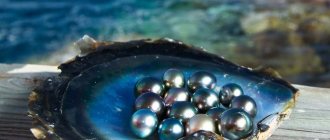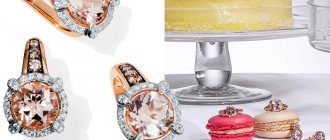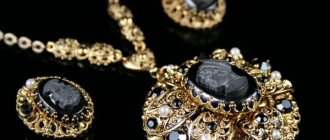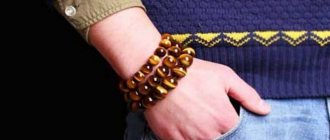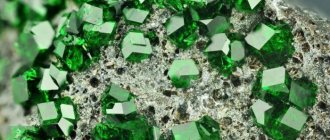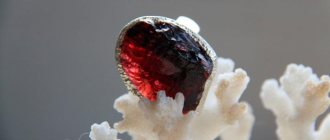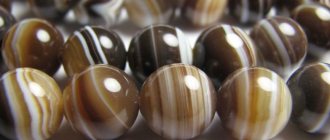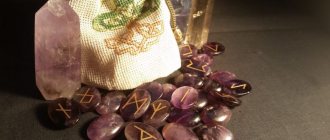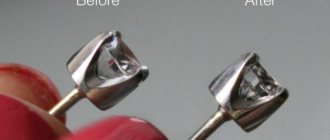- home
- Interesting things about gems
24.01.2018
The natural world of stones is beautiful and infinitely diverse: they can be large and small, colored and colorless, opaque and translucent, natural and artificial, durable and fragile... And many, many other characteristics. Scientists from different years and eras tried to classify stones and minerals based on different indicators, but the division always turned out to be conditional, with gaps and tolerances. For example, such a simple characteristic as color is objective and understandable to everyone. But it turned out that many gems come in a rich palette and change color depending on the lighting and viewing angle. Moreover, science does not stand still, knowledge changes and accumulates, and existing classifications become outdated.
Variations of the basic classification of stones
There is no generally accepted classification today. Jewelers divide stones according to one characteristics, mineralologists and geologists according to others. It all depends on the purpose of the separation.
In Russia, people most often turn to the classification of stones proposed back in 1973 by V. Ya. Kievlenko, which takes into account, among other things, cost characteristics. According to it, all precious and semi-precious stones of natural origin can be grouped into 3 classes:
- Jewelry (the most beautiful and valuable crystals; for example, diamond, sapphire, citrine);
- Jewelry and ornamental (colored stones, more used for crafts than in jewelry; for example, aventurine, amber and rose quartz);
- Ornamental (found application mainly for the manufacture of large stone-cutting products; good examples are jasper, selenite, colored marble).
The first and second groups are also distributed in orders of magnitude: 4 in the first and 2 in the second.
Jade carving
Academician A.E. Fersman has been studying the Ural deposits for a long time, one of the richest in Russia and throughout the world in terms of the variety and quality of gems, and at the beginning of the last century he proposed his own classification, which he later refined and developed. First, he identified transparent, regardless of their classification as ornamental and precious, and colored stones.
To designate the former, he used the concept of “gems,” which he adopted from the Ural prospectors - in them, “the color itself” determines their value.
The latter are used both for making jewelry and carved items. These are aggregates of rocks, crystals of varying degrees of transparency and other mineral formations of various colors and their combinations, with inclusions of various shades, shapes and structures.
In 1954, a significant clarification appeared. The first classification of precious and colored stones in Russia looked like this:
- Group A – cutting material;
- Group B – ornamental material.
Some items fall into both categories according to their application.
Gasketing, sealing and insulating materials and carbon graphite materials
Gasket and sealing materials are used to impart density and tightness to the connections of machine parts and eliminate possible leakage of liquid and gas breakthrough.
Insulating materials are organic and inorganic substances that have fire resistance and low thermal and electrical conductivity. They are used to insulate live parts of machines and electrical wires. The following cushioning and insulating materials are widely used:
- paper - sheet material made from plant fibers and cellulose;
- cellulose - plant fibers purified from resins and other components;
- cardboard - specially processed thick paper with a thickness of 0.25...3 mm. Depending on the processing method, it acquires oil and gasoline resistance, electrical and thermal insulation;
- fiber is a type of paper material impregnated with a solution of zinc chloride. It is highly durable and easy to machine, oil and petrol resistant. The disadvantage of fiber is its significant hygroscopicity, so when moistened it becomes deformed. Fibers are used for the manufacture of washers, gaskets and bushings;
- asbestos is a naturally occurring fibrous white mineral composed of silica and small amounts of iron oxide and calcium oxide. It is characterized by high fire resistance, as well as low thermal and electrical conductivity, and can withstand temperatures up to 500°C. Asbestos is used to make fiber, threads, cords, fabrics mixed with cotton and pure asbestos fabrics, sheet and cushioning asbestos materials, asbestos paper, cardboard;
- paronite - sheet material made of asbestos, rubber and fillers; used for sealing water and steam lines, as well as pipelines and fittings for petroleum products: gasoline, kerosene, oil;
- felt is a porous sheet material made from wool fibers. Air pores in it make up at least 75% of the volume. Felt has high heat and sound insulation, as well as shock-absorbing properties. It is used for packing stuffing boxes and making gaskets.
In mechanical engineering, sealing and sealing joints of parts is important. Various sealants are used for these purposes. The sealing liquid gasket GIPC-244 is intended for sealing fixed joints of parts and assembly units operating in water, steam-water, acid-base and oil-gasoline environments. Sealing putty U-20A is intended for sealing joints in air and water environments. Sealant elastosil 137-83
seals fixed joints in water, steam-water, acid-base and oil environments. Anaerobic adhesive DN-1 ensures sealing of joints with gaps up to 0.15 mm.
Mineral wool is a product of processing metallurgical or fuel slag. It serves to insulate surfaces with low and high heating temperatures. Mineral wool-based slabs glued with phenolic resin or bitumen emulsion are also used as insulating materials.
Insulating rubberized tape is a harsh thin cotton fabric (calico) impregnated on one or both sides with a sticky raw rubber mixture. Adhesive insulating tape is a plastic film coated with a layer of perchlorovinyl adhesive. Tape thickness is 0.20...0.45 mm, width - 15...50 mm.
Graphite-based materials are used to produce graphite-carbon materials, from which sliding electrical contacts, melting crucibles, casting molds, bearing materials, etc. are made.
Carbon-graphite antifriction materials are designed to work without lubrication as bearing supports, sealing devices and other rubbing parts in the temperature range from –200 to +2000°C at sliding speeds of up to 100 m/s and in aggressive environments. These include:
- graphite-plastic antifriction materials on an epoxy-organosilicon binder of the AMS-1, AMS-3, AMS-5 brands;
- graphite fluoroplastic materials based on fluoroplastic-4 grades AFGM, AFG-80VS, 7V-2A;
- antifriction graphitized materials of the NIGRAN and NIGRAN-V brands, etc.
Carbon-graphite materials with increased mechanical strength are used at elevated temperatures. Graphite for electrical discharge machining is produced in the form of bars of the EEG and EEPG grades; graphite grades MG, GMZ, PPG are used for the manufacture of crucibles, equipment for vacuum furnaces, heaters, protective covers of thermocouples, anti-corrosion and heat-resistant pipes, etc. Siliconized graphite SG-M, SG-T, SG-P is used for the manufacture of electric heaters operating in oxidizing conditions gas environments. Borosiliconized graphite BST-ZS is intended for the manufacture of heat-resistant foundry equipment. Graphite for the manufacture of chemical equipment of the ATM-1 and ATM-1T brands operates at temperatures from –18 to +150°C.
Classifications of ornamental stones according to various characteristics
Ornamental stones are valued much lower than precious stones. But there are many that are practically the same in price. A beautiful piece of bright green jade beads of uniform color with very rare and small inclusions can cost more than a million rubles.
According to the degree of hardness, ornamental stones are:
- Hard (agate and jade);
- Medium (coil and marble);
- Soft (onyx, malachite).
They are also classified by value. This indicator depends as much as possible on the individual properties of the stone: whether there are inclusions, color and its saturation, how rare the mineral is, whether it is difficult to extract and process. Valuable stones include malachites, quartzites, many types of marble and onyx.
Some ornamental stones are more correctly called rocks: they consist of several minerals at once and are found in nature in very large quantities. Take, for example, serpentine, lapis lazuli, granite, marble. They are used to make massive interior elements of large rooms, such as floor slabs and columns, and stair steps.
Archaeological finds indicate that crafts and jewelry made of colored stones were valued at all times, and people who had the skill of stone cutting were equated with magicians and wizards. We should not forget that magical powers have always been attributed to the minerals themselves.
The magical properties of aventurine
Our ancestors attached great importance to this stone.
Aventurine was believed to have special magic. In particular, the gem:
- Helps get rid of complexes and makes its owner more confident in their abilities.
- Charges with optimism and carries favorable energy.
- Helps attract and maintain love.
- Brings luck and luck in risky situations.
- Supports people seeking to change their lives.
- Helps find a way out of difficult situations.
- Promotes the development of communication skills and leadership skills.
- Improves intuition.
Aventurine is thoroughly imbued with natural energy, so it is somewhat difficult to handle. Such energy is considered unstable and capricious.
For this reason, it is not recommended to wear this stone for too long: it has the power to turn human energy 180 degrees.
The effective period for its use is considered to be the waning moon in early winter or autumn.
The magical properties of the aventurine stone are most clearly manifested in those people who are a little children at heart, or who are not burdened with constant worries.
The mineral does not help overly serious and responsible individuals. This is a stone of freedom and lightness, play and impromptu.
This is interesting! The magical properties of aventurine increase significantly when placed next to silver.
Glyptic art
Among others, one of the first arts associated with stone work was glyptics - miniature carving. Gems with male and female faces, silhouettes of animals and even entire paintings carved on gems and shells have been perfectly preserved, having passed through centuries and even millennia. In Ancient Mesopotamia already in the 4th millennium BC. e. they made carved figures of people and animals from stone, and 10 centuries later - intaglio gems. Examples of the art of ancient Sumerians have survived to this day - carved figures and inscriptions on cylinders made of chalcedony and jasper. Stone carving was also used to make seals.
There are 2 types of gems:
- With an in-depth image (intaglio);
- With convex (cameo).
In the tomb of King Tutankhamun, which survived the hands of robbers, scientists discovered jewelry made of lapis lazuli and turquoise. In Ancient Egypt, lapis lazuli was considered one of the most expensive stones, it was called the “son of heaven”, it was considered the personification of the fact that the ruler is the earthly viceroy of the sun god Ra, therefore it was often used in the manufacture of statues of pharaohs and gods, gems, and body jewelry. A scarab beetle made of blue stone was placed into the heart of a deceased ruler during embalming.
Cameo agate carving
The first cameos began to be made in the 4th-3rd centuries. BC. The carving was done on sardonyx and agate: the craftsmen already had knowledge about the multi-layering of stones, and used them in their work to obtain smooth or, conversely, contrasting color transitions.
Initially, gems were used only as decorations and talismans, but later they received the status of seals, which at that time replaced the signature of an important person, the lock, and the key to it. Rich nobles collected entire collections of gems; at the imperial and royal courts there was a separate position of carver.
In ancient Slavic culture, stone processing initially consisted of creating polished asymmetrical cabochons that preserved the pristine beauty of the minerals. Among the monuments of the pre-Mongol era you can see amber, quartz, carnelian necklaces and earrings, and handicrafts made from river pearls. Over time, the art of making frames has developed greatly, which, thanks to the skillful hand of the master, emphasizes and enhances the beauty of minerals.
Pomegranate intaglio
Particular value was attached to stone-cutting crafts primarily because of their durability - jewelry and other products passed from generation to generation, surviving any wars, epidemics and natural disasters. The many statues of different eras, varied in beauty, manufacturing technique, and materials used, are excellent proof of this. In ancient times, Greek masters created individual sculptures and entire ensembles; they preferred fragile marble, believing that only it could truly reflect the beauty and grace of the human body. A masterpiece of a much later time (mid-19th century) by Raphael Monti, made from a special type of marble, amazes the human eye with the delicacy of its work: it is difficult to believe that the “Marble Veil” was carved from stone.
Lubricating oils and greases
The main function of lubricants is to reduce friction and eliminate the associated phenomenon of jamming of moving parts of machine parts and mechanisms. Lubricants also reduce power loss due to friction, remove heat and protect lubricated surfaces from the action of substances that cause corrosion and rusting. In many cases, the lubricant is the sealing medium. Currently, the main lubricants are mineral oils and lubricants obtained from petroleum feedstocks, greases and lubricating coolants.
All mineral oils are divided into four groups according to production method and composition: distillate, residual, mixed and oils with additives. According to the reagents used in processing, they are divided into three main groups: selectively purified oils, sulfuric acid purification and hydrogenation purification. Depending on their viscosity, mineral oils are divided into light, medium and heavy. Based on their primary areas of application, all lubricating oils are divided into the following groups: industrial (velocit, vaseline, spindle 2, IS-12, separate T, VNII NP-401, IS-45, machine SU, IST-11, cylinder 24, etc.) ; aviation (MK-8, MS-14, MS-8, MK-22, MS-20Sp, etc.); motor (motor transport Asp-6, automobile AS-9.5, tractor AK-15, diesel Dp-8, diesel D-11, M-10G, MT-8p, M-19D, etc.); transmission (TS-14.5, TAD-17, Arctic TSP3p-9, automobile, for trolleybus gearboxes, etc.); vacuum; for steam and refrigeration machines (cylinder 24, cylinder 52, HA. HA-23, HF-22-24, etc.); compressor (K-12, K-19, MK-22p, K-28, etc.); sentries, etc.
The main indicators of the quality and purpose of mineral oils are viscosity, flash point and pour point, stability against oxidation, anti-corrosion properties, etc.
Greases include liquid oils and solid thickeners. They are classified according to their main areas of application. In this case, general-purpose antifriction lubricants (solidol) are isolated; multi-purpose lubricants; high-temperature (VNPI NP-214, CIATIM-221s. VNIINP-246, PFMS-4S, VNPP NP-225, NK-50, etc.);
low-temperature (MS-7), GOP 54p, CIATIM-200, etc.); instrument lubricants; lubricants resistant to aggressive environments; industrial (IP-1, No. 137, LS-1p, etc.); specialized automobiles and a number of others.
Artistic stone carving
This ancient art originated in China about 4 thousand years ago. Craftsmen carefully preserve the secrets of their craft and pass them on from generation to generation. Initially, jade was used as a base: regalia, body jewelry, decorative items and dishes were cut out of it. Jasper, the embodiment of virtue on Earth, was used to make religious and ritual items. Every Chinese emperor always had a personal seal made of jasper. Bottles were cut from agates and chalcedony. Turquoise, rock crystal, and amethyst attracted craftsmen with their richness of color and hardness. Eastern masters valued natural materials primarily for texture, fancy colors and shapes. Each stone was examined for a long time before work, in order to use every inclusion and vein in skillful work. “Yu carving” is still flourishing today – factories for the production of jade cups have become one of the tourist attractions of China.
Medicinal properties
The healing properties of aventurine apply to all human systems and organs.
With its help you can avoid the following diseases:
- Chronic skin diseases (eczema, dermatitis, subcutaneous rash, etc.). It does not get rid of the disease completely, but it helps the skin recover well. To do this, the mineral must be worn next to the lesion. For example, if allergies appear on your hands, it is enough to wear an aventurine bracelet.
- Colds , bronchitis. Jewelry with a stone must be worn around the neck.
- Thyroid diseases.
- High blood pressure. A ring framed with aventurine will help normalize blood pressure.
- Diabetes. It is enough to wear a small pendant with a gem.
- Hair loss.
- Depression and blues. It is necessary to wear a mineral set in gold on the middle finger of the hand.
In addition, aventurine helps normalize metabolism and restore the body after indigestion. The appearance of the stone has a positive effect on those who suffer from various mental disorders. In this case, massage balls will be required.
For the purpose of prevention, aventurine should be worn 4 days a week and then take a three-day break. You can wear the stone for a maximum of a month without removing it. In no case is it worth it longer. When worn for a long time, aventurine promotes excessive activation of all processes in the body, and this can cause an imbalance of energies.
Mosaic art
One of the artistic trends in the use of ornamental stone has become mosaic - creating a single image from small pieces, in this case stones. Precise selection of the shape and color of individual components gives smooth color transitions and clear lines of the overall picture.
Roman mosaic
Art has been known since ancient times, when the Greeks (2nd century BC) were famous for their skill in this field. In the Roman Empire, which was rapidly growing richer and developing during the era of Julius Caesar, Greek craftsmen were invited to work and train apprentices - this is how the technique of Roman mosaics was born on the Apennine Peninsula. At first, the drawings were very simple: a set of geometric shapes and inscriptions. And the material was simple pebbles. But gradually the art of mosaic developed, the technique was honed, and the images became more and more skillful, they were like paintings: colored glass (smalt), marble, limestone, and ornamental stones were added to the pebbles; the seams became thinner, they were filled with paint to match. Mosaic became so widespread that it was used to decorate floors, walls, and ceilings by both ordinary Romans and the richest, and they even used it to pave roads.
Florentine mosaic
Mosaic art received a revival in the Middle Ages in Italy, or more precisely in Florence, hence the name of the new technique - Florentine mosaic. It is distinguished by its high complexity and thoroughness, and at the same time high artistic value. An ideal solid pattern is obtained through skillful cutting and adjustment of stones in size and color, forming images without seams (comesso), with smooth lines and complex shapes, subtle color transitions.
In the 16th century n. e. Ferdinand I of the famous Medici dynasty opened the stone-cutting workshop “Gallery Dei Lavori”, where the first experiments in composing colored stone paintings began. Craftsmen created boxes, game boards, plaques, tabletops, and other furniture elements. Most of all, natural materials were used such as jasper, agate, onyx, marble, chalcedony, quartz, rock crystal - the so-called “pietra dura” (hard stones). For each mineral, a special method of preparation and processing was selected in order to make maximum use of the color capabilities of the material. The art of Florentine mosaic flourished until the 19th century, when people's interest in it faded away, turning to painting and architecture.
Russian mosaic
Russian mosaic is also known, which appeared thanks to M. Lomonosov in the 18th century. It is strikingly different from the Florentine one:
- It is performed not only on flat, but also on curved surfaces;
- On a base of durable inexpensive stone, a pattern of malachite (or other colored stone) plates is glued, creating the impression of a monolith;
- Symmetrical, diverging patterns;
- Sometimes the size is impressive (masters created countertops, doors, columns, entire rooms).
It is worth noting that malachite itself is completely unremarkable in appearance; wonderful natural patterns are revealed when cutting the stone into layers. Ural craftsmen used this stone-cutting technique to work with jasper and lapis lazuli.
Rubber materials
Rubber is a product of chemical processing of rubber, obtained as a result of vulcanization.
The most common vulcanizing agent is sulfur. During the vulcanization process (heating in sulfur vapor), the linear structure of rubber turns into a spatial structure due to the fact that sulfur, reacting with carbon atoms that have double bonds before vulcanization, connects macromolecules. During vulcanization, thermoplastic plastic turns into a thermoset with a spatial structure. In addition to rubber and vulcanizer, rubber includes:
- antioxidants (antioxidants) - substances that prevent the oxidation of rubber; they bind oxygen that has diffused into the rubber (chemical), or form protective films that protect against oxidation (physical) - paraffin, wax;
- plasticizers that facilitate the processing of rubber mixtures - paraffin, petroleum jelly, etc.;
- fillers - active (carbon black, silicon and zinc oxides), participating in the formation of a three-dimensional structure and therefore increasing quality properties;
- inert materials (chalk, talc), introduced to reduce costs;
- mineral or organic dyes that perform a decorative function. In addition, by absorbing the short-wave part of the solar spectrum, they delay light aging of rubber.
During operation, rubber products are subject to various types of aging (light, ozone, heat, etc.). As a result of aging, irreversible changes in properties occur.
An increase in temperature reduces the strength of rubber; the operating temperature of non-heat-resistant rubber does not exceed 150°C, and of special heat-resistant rubber - 320°C.
At low temperatures, transformation into a glassy state and loss of elastic properties occur. Rubber products can be used at temperatures from –30 to +80°C.
According to their intended purpose, rubber can be general purpose or special. General purpose rubbers include NK, SKB, SKS, SKI: NK - based on natural rubber, SK - synthetic. Special rubbers include oil- and gasoline-resistant, heat-resistant, frost-resistant, light-ozone-resistant, wear-resistant and electrical.
Electrical rubbers are divided into electrically insulating and electrically conductive. Electrical conductivity is achieved by introducing carbon black and graphite into rubber.
Belts, sleeves, transport belts, gaskets are made from general-purpose rubber (a low elastic modulus determines high vibration-damping properties), etc.
Which zodiac signs is it suitable for?
- Aventurine has a beneficial effect on Gemini, Virgo, Taurus and Aquarius.
- Representatives of the elements of Water, Scorpios, Pisces and Cancers, will gain determination and perseverance thanks to the stone.
- Aventurine will endow Virgo with intuition and gentleness, Taurus with lightness, Gemini with grace, and Aquarius with confidence.
- Aventurine amulet should be worn with caution by Capricorns. The gem is not very favorable for people who take on great responsibility.
Unfortunately, aventurine is not recommended for Fire signs - Leo , Sagittarius and Aries. Otherwise, they will suffer disappointments in love and material difficulties.
How to distinguish a fake from a real aventurine?
Due to the structure of the gem, it is easy to fake. This is often used by scammers. Often, when purchasing a magic stone, they slip in a beautiful imitation or glass trinket.
The most commonly counterfeited aventurine is black and golden brown.
To protect yourself when purchasing, please note the following:
- The color of real aventurine should be bright and slightly shiny.
- Too much shine indicates that the stone is made of glass.
- If there are inclusions, they must have the correct shape.
- The price of the stone is too low.
- Very large mineral size.
This is interesting! You can check the naturalness of the stone in another way - run it across the glass. If there is a scratch on the glass, you have natural aventurine.
A fake will not do you any harm, but it will not do you any good either. Therefore, look carefully at what you buy.
